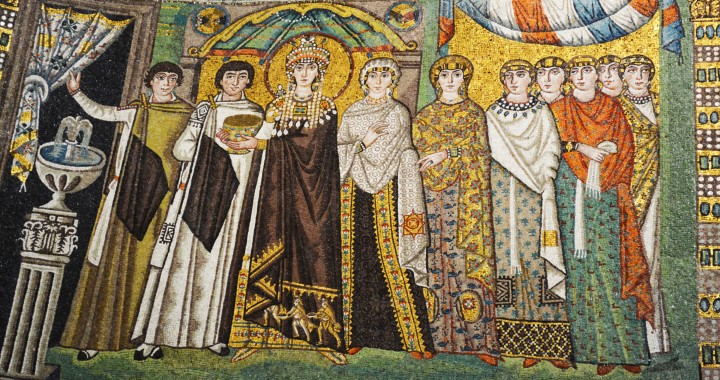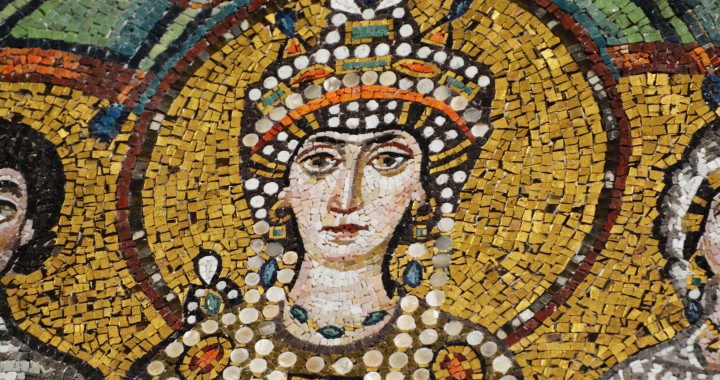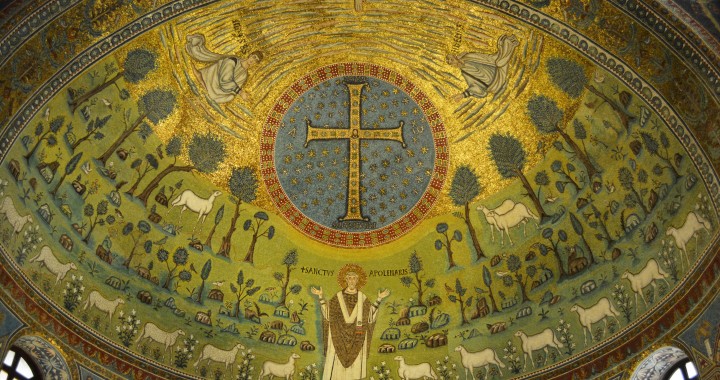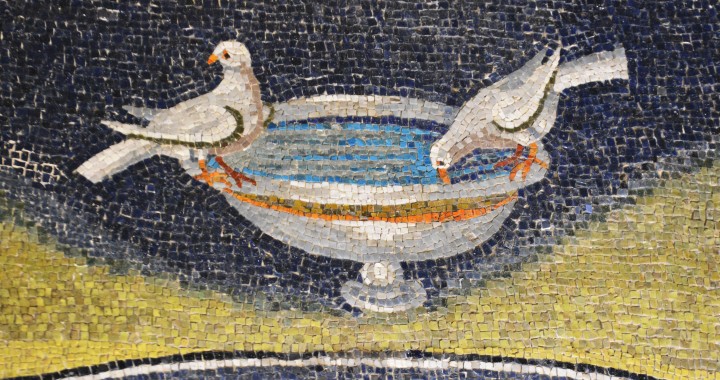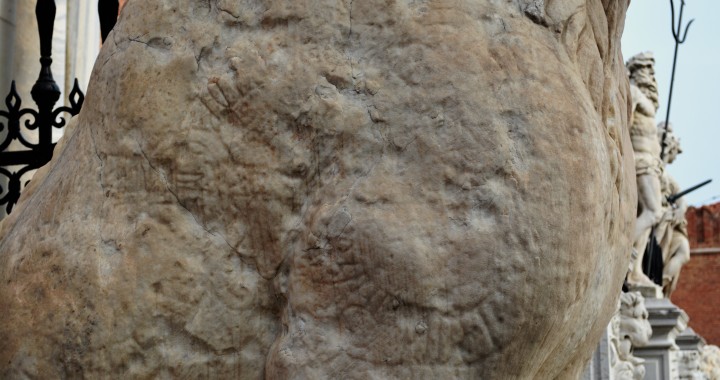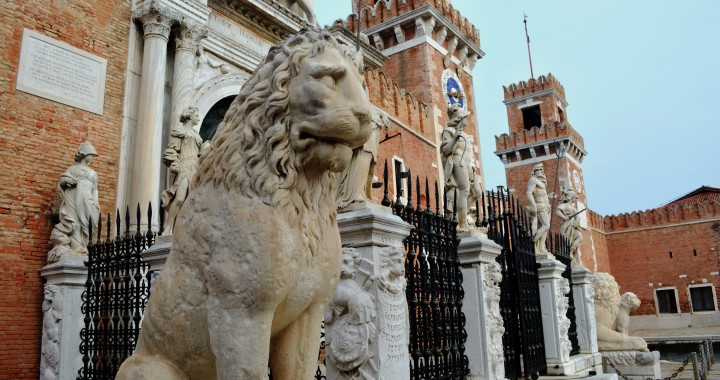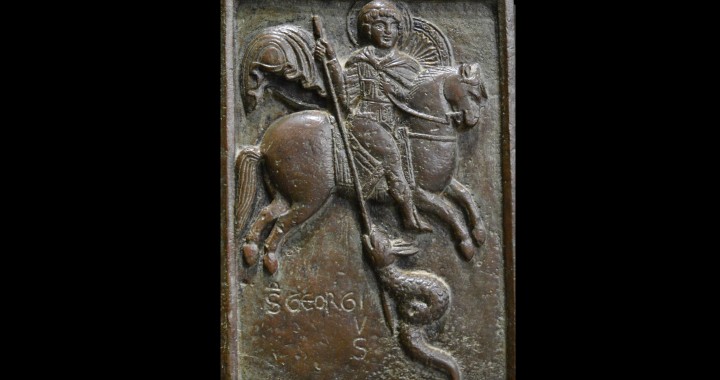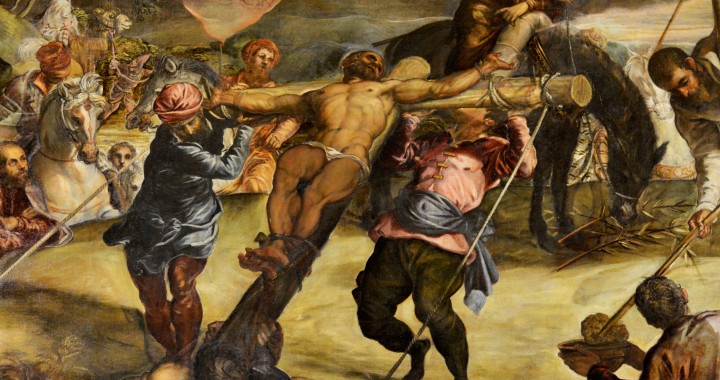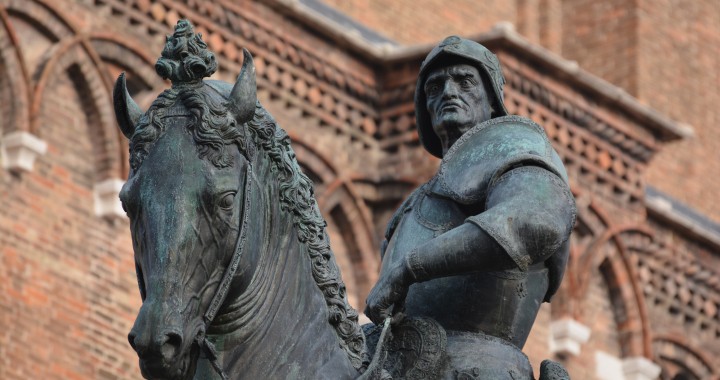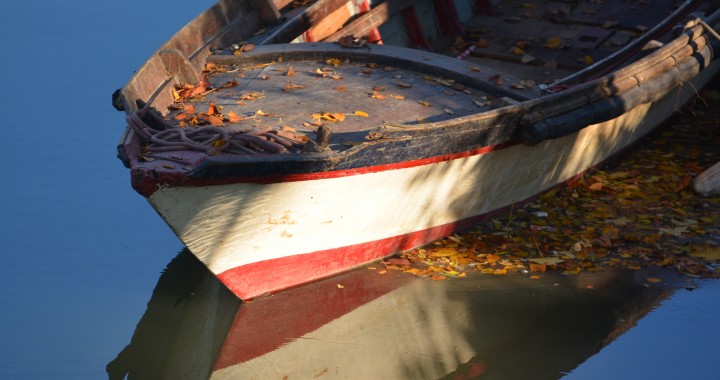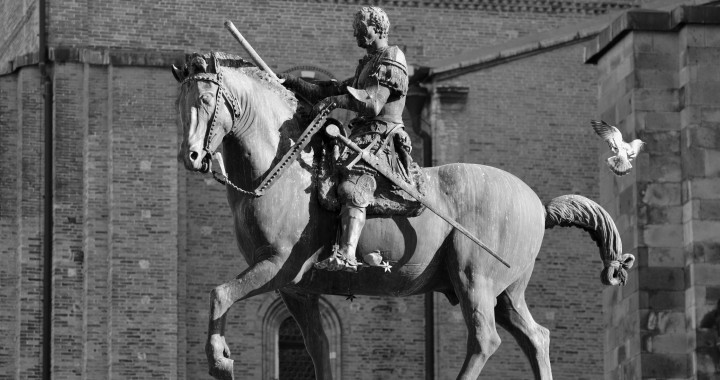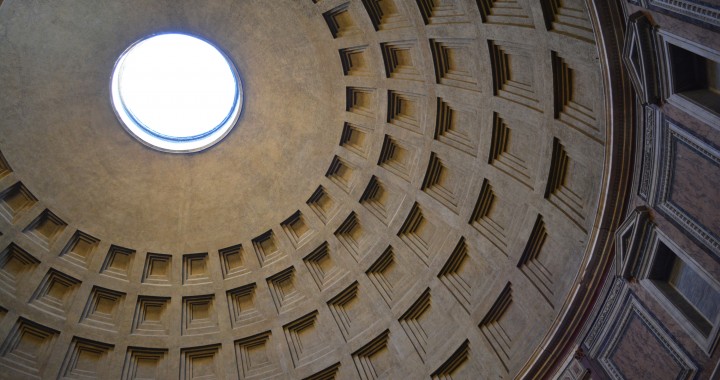Empress Theodora at San Vitale, Ravenna
I can’t tell you how difficult it was to get this picture. I had to take 25 out-of-focus ones before I finally managed to steady myself enough in the dark interior, from a distance of about 30 feet with the 300 mm lens. This is a detail of a famous mosaic of the Byzantine Empress Theodora in a procession of court ladies and attendants donating a golden bejeweled, liturgical bowl to a church. She is in splendid imperial purple robes (I’ll put an image of the whole piece above) and decorated with sumptuous jewelry. Her court ladies are lovely and also in their Sunday best. It’s just one of Ravenna’s wonders, and for a day ticket of only 9.50 euro, you can visit all the churches, many of them UNESCO World Heritage sites, in the city.
Sant’ Apollinaire, Ravenna
The semi-dome of the church of Sant’ Apollinaire in Classe, just outside the modern city of Ravenna, is a wonder and could be my favorite single mosaic work (use your browser’s ‘back’ button to return to this site). In terms of size it’s big, rivaling some of the apse mosaics in the early Christian churches of Rome. But the colour is the real attraction: a lovely green creating a verdant landscape of paradise, which Saint Apollinaire, in the center, seems to welcome you to with open arms. The springtime landscape is filled with sheep (i.e. Christians) who line up to enter. All about are plants and trees, and birds can be found scattered everywhere. Above, a great cross floats in a blue heaven with golden stars. At the very apex the hand of god comes out of a cloud to bless Apollinaire. The whole scene glows with life and freshness, something I’ve never seen in any other mosaic.
Ravenna and the Glories of Byzantium
It seems strange that if you want to see the most impressive examples of Byzantine mosaics anywhere they are not to be found in Turkey or in Greece, but in Ravenna, Italy. Nowadays a sleepy minor port town, 1500 years ago it was the capital of the Western Byzantine empire and was patronized by emperors and empresses (see post above). One reason they survive here and not elsewhere in the lands that we most associate with Byzantium is that the Byzantines themselves destroyed much of their own figural art (paintings, mosaics, statues) in the periods of iconoclasm in the 9th and 10th centuries. So pre-iconoclastic period Byzantine art is rare, but by the iconoclastic period Ravenna was no longer in the sphere of the capital, and thus its works survived. Mosaics are my favorite mural art form, and I’ve seen some of the best in my travels. Ravenna is still a very special place and I’ll post a few images today. This little detail is from the Mausoleum of Galla Placidia from the 5th century. It shows doves drinking from a bowl, a motif that is seem elsewhere in the building. It alludes to paradise and the clear waters of the rivers of paradise, from which one will be able to drink freely. So the idea of salvation fits with the structure’s funerary context and the hope for a life in heaven thereafter.
A Detail for Previous Post
The runes are difficult to see in the previous picture, so here’s one that shows a close-up. I’ve increased the contrast in Photoshop to make the inscriptions, or what’s left of them after 1000 years, a bit more legible.
If this Kitty Could Talk
Yesterday I was in Venice and went to the Arsenale Gate, the monumental gateway to Venice’s medieval and renaissance-era shipyards and armaments factory area. The gateway was constructed in the late 15th century (1460), but substantially enlarged after 1571 in celebration of the naval victory at the Battle of Lepanto, which checked Ottoman advancement into the Adriatic. Part of the ancillary decorations are a series of lions stolen from various places throughout Venice’s colonial empire. See the one peeking his head out in the distance on the right? He’s from the island of Delos, in the Aegean, and he’s ancient Greek in origin, probably about 2500 years old. Several of his former mates are still standing there on Delos. The big fellow in the foreground left is the guy I want to talk about. He’s known as the ‘Piraeus Lion’. He, too, is an ancient Greek lion, from the 4th century BC. So around 2400 years old. He came from the port of Athens, Greece, which is how he got his name (Piraeus is the port of Athens). Where he originally came from is anybody’s guess, the Romans had put him in place in Piraeus in the first or second century CE. Italian voyagers called Piraeus ‘Porta Leone’ because of this lion. At some point, he was part of a fountain and spewed water from his mouth (the tubing still exists in his body). He was taken away by the Venetian commander Francesco Morosini in 1687. Morosini had been in Athens trying to take the city from the Ottoman Turks. It was one of his rockets that landed in the gunpowder magazine of the acropolis, which happened to be in the Parthenon, thus blowing out the entire south side of columns. So when you go there and see that big space with no columns you can think of dear Francesco. Morosini took, as part of the loot, this lion, and placed it at the Arsenale Gate as a monument to his victory. If that isn’t interesting enough, do you see that curving line on the lion’s ‘shoulder’? There are other curving lines and text is visible. They’re runic inscriptions carved by Viking Varangian soldiers who served the Byzantine emperors. They carved graffiti into the lion some time in the 11th century while the lion was in Piraeus. The Vikings, when they took the port, lost a kinsman named Horsi, and carved the runes in his honour. Part of the inscription reads: “They cut him down in the midst of his forces. But in the harbor the men cut runes by the sea in memory of Horsi, a good warrior. The Swedes set this on the lion. He went his way with good counsel, gold he won in his travels.The warriors cut runes, hewed them in an ornamental scroll. Áskell [and others] and ÞorlæifR had them well cut, they who lived in Roslagen. [N. N.] son of [N. N.] cut these runes. UlfR and [N. N.] colored them in memory of Horsi.” Apparently they were painted when originally done. Like I say, if this lion could talk. It seemed banal to reduce this magnificent feline to the symbol of the evangelist St Mark; he was a creature who stood proud over ancient centuries long before St Mark ever walked the earth.
